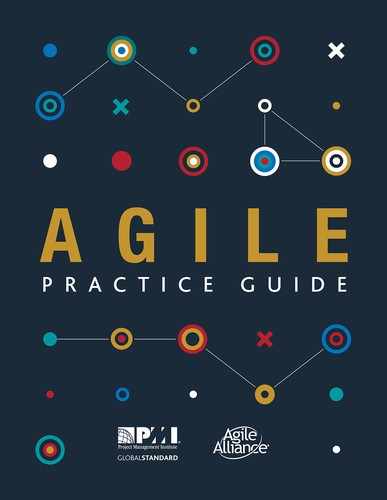TABLE OF CONTENTS
2.1 Definable Work vs. High-Uncertainty Work
2.2 The Agile Manifesto and Mindset
2.3 Lean and the Kanban Method
2.4 Uncertainty, Risk, and Life Cycle Selection
3.1 Characteristics of Project Life Cycles
3.1.1 Characteristics of Predictive Life Cycles
3.1.2 Characteristics of Iterative Life Cycles
3.1.3 Characteristics of Incremental Life Cycles
3.1.4 Characteristics of Agile Life Cycles
3.1.5 Agile Suitability Filters
3.1.6 Characteristics of Hybrid Life Cycles
3.1.7 Combined Agile and Predictive Approaches
3.1.8 Predominantly Predictive Approach with Some Agile Components
3.1.9 A Largely Agile Approach with a Predictive Component
3.1.10 Hybrid Life Cycles as Fit-For-Purpose
3.1.11 Hybrid Life Cycles as Transition Strategy
3.3 Project Factors That Influence Tailoring
4. IMPLEMENTING AGILE: CREATING AN AGILE ENVIRONMENT
4.1 Start with an Agile Mindset
4.2 Servant Leadership Empowers the Team
4.2.1 Servant Leader Responsibilities
4.2.2 Role of the Project Manager in an Agile Environment
4.2.3 Project Managers Use Servant Leadership
4.3.3 Generalizing Specialists
4.3.7 Overcoming Organizational Silos
5. IMPLEMENTING AGILE: DELIVERING IN AN AGILE ENVIRONMENT
5.1 Charter the Project and the Team
5.2.6 Planning for Iteration-Based Agile
5.2.7 Execution Practices that Help Teams Deliver Value
5.2.8 How Iterations and Increments Help Deliver Working Product
5.3 Troubleshooting Agile Project Challenges
5.4 Measurements in Agile Projects
5.4.1 Agile Teams Measure Results
6. ORGANIZATIONAL CONSIDERATIONS FOR PROJECT AGILITY
6.1 Organizational Change Management
6.1.1 Drivers for Change Management
6.2.1 Creating an Environment of Safety
6.5 Multiteam Coordination and Dependencies (Scaling)
6.6 Agile and the Project Management Office (PMO)
6.6.1 An Agile PMO is Value-Driven
6.6.2 An Agile PMO is Invitation-Oriented
6.6.3 An Agile PMO is Multidisciplinary
ANNEX A2
AGILE MANIFESTO MAPPING
ANNEX A3
OVERVIEW OF AGILE AND LEAN FRAMEWORKS
APPENDIX X1
CONTRIBUTORS AND REVIEWERS
APPENDIX X2
ATTRIBUTES THAT INFLUENCE TAILORING
